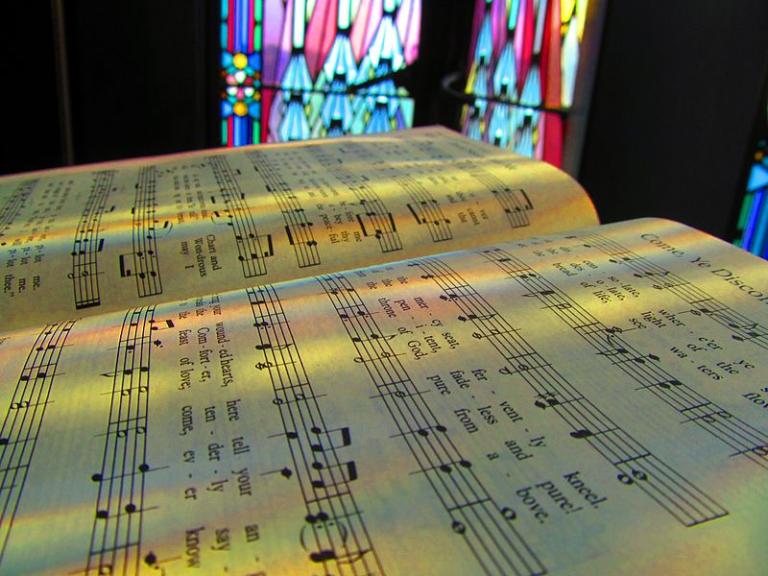Note: I am not suggesting a return to congregational singing until scientific consensus states that it is safe. This is not about singing. Rather, many churches are removing hymnals, but projecting hymn texts as they are sung or played by musicians.
Seriously, don’t get rid of your hymnals.
You don’t need to get rid of your hymnals to protect from the COVID-19 virus. At least not entirely. But first, let’s talk about why hymnals are important to keep around, even if public singing has yet to resume.
Hymnals allow people to take possession of the music.
Beyond that, I know congregants that love to find out the next Sunday’s hymns during the previous week, so they can open up their hymnal, refresh the words, and work on their part. Preparation like that is, on its own, an act of personal devotion and worship.
Hymnals are a theological textbook.
Hymnals are hand-held volumes of Christian theology, cohesively and beautifully stated by saints throughout the millennia. Having it in your possession and consciously taking in the printed words is a formative experience like no other.
Hymnals involve tactile action.
Hymnals make the people work. Picking up the hymnal, finding the right page, and holding it up to sing grounds you in time and space. Feeling the weight in your hand engages you in the activity more than staring at a screen ever could. Especially in this time when we’re deprived of physically engaging with the world around us, this tactile action keeps people engaged in worship, even if they aren’t able to sing.
Hymnals are not distracting in the way screens are.
Anyplace where screens are present and in use, we automatically orient ourselves so that they are the center of attention. We are trained to look at screens whenever they are on, which causes us to ignore the rest of what is around us. In liturgy, this means we are distracted from the entirety of the drama playing out in front of us, and we are distracted from our fellow worshipers and leaders. With all of its benefits to our society, technology is isolating.
Screens are difficult to follow.
In addition, screens are actually very difficult to follow. Whenever I’m forced to read a projected text, I am so easily lost in the colors, backgrounds, and movements. I find myself anticipating when the next slide will be advanced. When I’m using a hymnal, none of that comes into play. I have the words and music, and I don’t even have to worry about turning the page.
Hymnals preserve the aesthetics of the Sanctuary.
There is rarely a good place to hang a screen. Even worse, when installed into older spaces, the result can be a visual nightmare. After centuries of designing liturgical architecture to be beautiful and reflective of our communion with the kingdom of heaven, we have now made them entirely pragmatic. The introduction of technology into sacred architecture has hastened this descent from architectural beauty to stark ugliness.
Hymnals are reminders that God and the life of prayer continue after the screen goes dark.
The words on the screen, like most modern pop worship ditties, are fleeting. They’re here one instant, and they’ve disappeared the next. Okay, obviously you can throw a hymnal away if you want, but text on a screen is there one second and gone the next. There’s no visible permanence. Hymnals are symbols of consistency. They give life and breath to the great musical expressions of faith. They demonstrate that what we sing is worth keeping around.
By the way, all of these are good reasons to get rid of your screens, too. I’ve written about this a bunch of times.
How can we use hymnals safely?
I’m in no way suggesting you ignore any official legal or medical guidelines.
I am, however, suggesting that you find ways of keeping hymnals a part of your worship. You don’t need to install costly and intrusive projectors and screens. You don’t need to waste a bunch of extra paper and toner on expanded leaflets. Just use some common sense. Here are some suggestions:
1. Encourage congregants to bring their own.
If people can afford it, encourage them to purchase their own hymnal. Used copies can often make this more affordable. If they can’t afford it, perhaps the church could as a ministry.
2. Check out hymnals to individuals and families.
Have a system for checking out hymnals as if they were library books. Allow them to bring them to worship, once in-person worship has resumed, or use them from home.
3. Disinfect the covers after each service.
This would be most practical for smaller churches with only one service. According to multiple reports, including this recent one from Harvard Medical School, the virus is unlikely to survive on any surface from one Sunday to the next.
Basically, hymnals are important. Don’t get rid of them in an attempt to create a false sense of security.
Photo:
wikipedia commons











